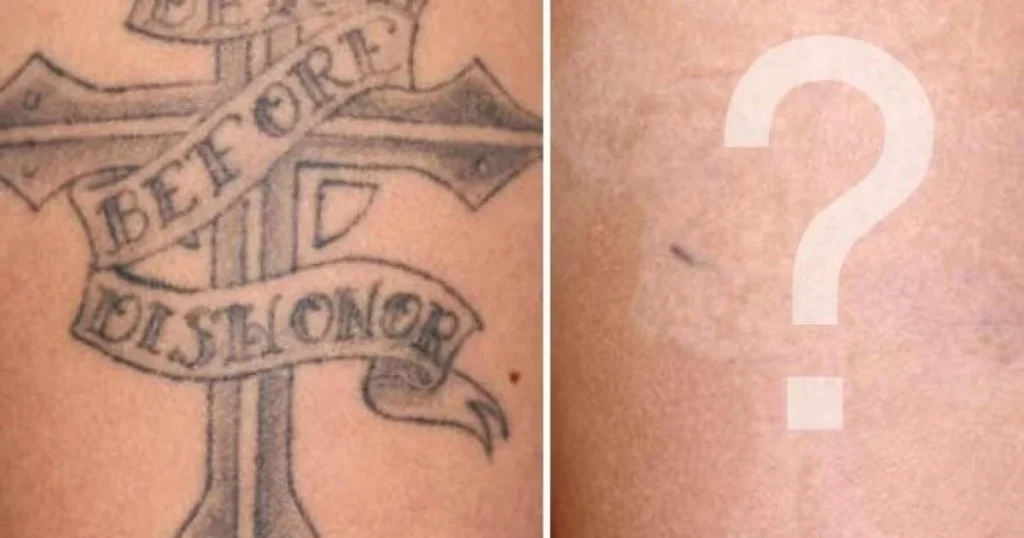Dark tattoo removal can be a transformative process, especially for those looking to lighten or fully remove tattoos that no longer hold meaning, or that are simply too bold or intense. The process involves a combination of technologies, most notably laser treatment, to break down the pigments and allow the body to gradually eliminate the ink. Here’s a closer look at what to expect before and after dark tattoo removal.
Table of Contents
ToggleBefore Dark Tattoo Removal
- Consultation and Assessment
- Skin Tone and Tattoo Characteristics: During your consultation, a professional will assess your skin type, the location of the tattoo, the colors used, and the size of the tattoo. Dark tattoos (especially black ink) are often harder to remove than lighter-colored ones due to the density of the pigment.
- Health Status: The technician will review your health to ensure you’re fit for the procedure. Certain medical conditions and medications can affect the healing process or increase the risk of complications.
- Preparation
- Avoid Sun Exposure: Prior to your tattoo removal treatment, it’s important to avoid sun exposure in the area. Sunburned skin can make the procedure less effective and increase the risk of scarring.
- No Scratching or Picking: To ensure the treatment area is clean and ready for the procedure, avoid scratching, peeling, or picking at the tattoo before treatment.
- Pain and Sensitivity
- Pain Management: While laser tattoo removal is generally not unbearable, it can be uncomfortable. Many clinics offer numbing creams or local anesthesia to make the experience more tolerable.
- Skin Sensitivity: The skin around the tattoo will be more sensitive leading up to the procedure. It’s essential to follow any pre-treatment guidelines provided by your technician.
During Dark Tattoo Removal
- Laser Treatment Process: The most common method for dark tattoo removal is the Q-switched laser, which targets the tattoo pigments with intense light pulses. The laser breaks down the ink into smaller particles, allowing your body to absorb and remove it over time. Black and dark tattoos, which contain solid pigments, are generally the easiest to treat, but may require more sessions compared to lighter tattoos.
- Time per Session: Sessions can last anywhere from 15 minutes to an hour, depending on the size of the tattoo. Dark tattoos often require multiple treatments.
After Dark Tattoo Removal
- Immediate Post-Treatment Care
- Redness and Swelling: Immediately after the procedure, the treated area may be red and slightly swollen. This is a normal reaction to the laser treatment.
- Blistering and Scabbing: It’s common for small blisters or scabs to form in the first few days after treatment. Avoid popping blisters or picking at scabs, as this can increase the risk of scarring or infection.
- Cooling the Area: Cold compresses or ice packs can help reduce swelling and discomfort after treatment.
- Healing Process
- Fading Over Time: The tattoo will gradually fade as the ink breaks down. It’s important to wait several weeks (typically 4-6 weeks) between treatments to give the skin enough time to heal and for the body to process the broken-down ink.
- Moisturizing and Protecting: Applying ointment or moisturizer can help soothe the skin. You’ll also need to avoid sun exposure to prevent pigmentation changes in the treated area.
- Expected Results
- Multiple Sessions Required: It usually takes 6-10 sessions (or more) to fully remove a dark tattoo, depending on the ink’s depth, the tattoo’s size, and the color.
- Gradual Fading: While some fading will occur after the first session, significant changes might not be seen until after a few treatments. Full removal can take several months or even a year.
- Possible Side Effects
- Hypopigmentation or Hyperpigmentation: Some individuals may experience light or dark patches on the skin after treatment, especially if the skin is exposed to sunlight before it has fully healed.
- Scarring: Though uncommon, scarring is possible, particularly if aftercare instructions are not followed properly. Scar tissue formation may depend on skin type and how the skin reacts to laser treatment.
Before and After: The Transformation
Before Tattoo Removal:
- Visible, Bold Tattoo: Dark tattoos often appear very prominent, with intense black ink that can be difficult to cover with other ink or makeup.
- Emotional and Aesthetic Impact: The tattoo may no longer fit the individual’s style or aesthetic, leading to a desire for removal.
After Tattoo Removal:
- Gradual Fading: After several sessions, the tattoo will begin to fade significantly, with the black ink becoming lighter and less pronounced.
- Clearer Skin: Over time, the skin will heal and become clear, with the tattoo eventually disappearing in some cases.
- Potential Scarring: If the treatment has been successful and there are no complications, the skin should return to a more natural appearance, though slight scarring may remain in some cases.
In Summary: Dark tattoo removal before and after details an effective but gradual process that requires patience and care. The use of lasers can successfully break down dark inks, but the skin needs time to heal between treatments. Results vary by individual, but with multiple sessions, many people see a significant reduction or full removal of the tattoo, leaving their skin looking clear and natural again.
For more detailed info about matching tattoos, please visit tattooculturecollective.com.



